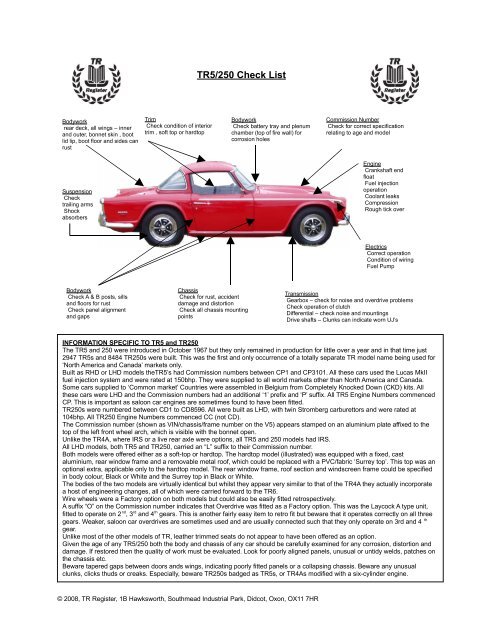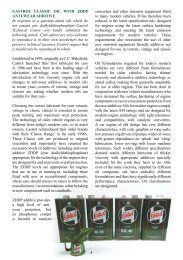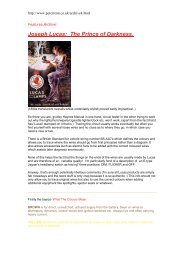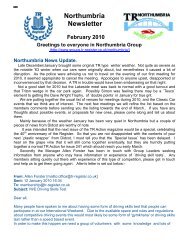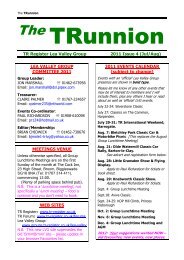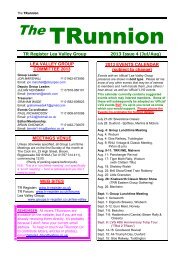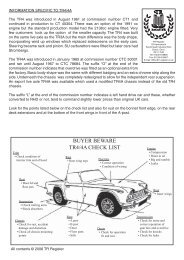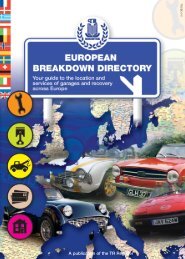Create successful ePaper yourself
Turn your PDF publications into a flip-book with our unique Google optimized e-Paper software.
Bodywork<br />
rear deck, all wings – inner<br />
and outer, bonnet skin , boot<br />
lid lip, boot floor and sides can<br />
rust<br />
Suspension<br />
Check<br />
trailing arms<br />
Shock<br />
absorbers<br />
Bodywork<br />
Check A & B posts, sills<br />
and floors for rust<br />
Check panel alignment<br />
and gaps<br />
Trim<br />
Check condition of interior<br />
trim , soft top or hardtop<br />
<strong><strong>TR</strong>5</strong>/250 Check List<br />
Chassis<br />
Check for rust, accident<br />
damage and distortion<br />
Check all chassis mounting<br />
points<br />
Bodywork<br />
Check battery tray and plenum<br />
chamber (top of fire wall) for<br />
corrosion holes<br />
INFORMATION SPECIFIC TO <strong><strong>TR</strong>5</strong> and <strong>TR</strong>250<br />
The <strong><strong>TR</strong>5</strong> and 250 were introduced in October 1967 but they only remained in production for little over a year and in that time just<br />
2947 <strong><strong>TR</strong>5</strong>s and 8484 <strong>TR</strong>250s were built. This was the first and only occurrence of a totally separate <strong>TR</strong> model name being used for<br />
‘North America and Canada’ markets only.<br />
Built as RHD or LHD models the<strong><strong>TR</strong>5</strong>’s had Commission numbers between CP1 and CP3101. All these cars used the Lucas MkII<br />
fuel injection system and were rated at 150bhp. They were supplied to all world markets other than North America and Canada.<br />
Some cars supplied to ‘Common market’ Countries were assembled in Belgium from Completely Knocked Down (CKD) kits. All<br />
these cars were LHD and the Commission numbers had an additional ‘1’ prefix and ‘P’ suffix. All <strong><strong>TR</strong>5</strong> Engine Numbers commenced<br />
CP. This is important as saloon car engines are sometimes found to have been fitted.<br />
<strong>TR</strong>250s were numbered between CD1 to CD8596. All were built as LHD, with twin Stromberg carburettors and were rated at<br />
104bhp. All <strong>TR</strong>250 Engine Numbers commenced CC (not CD).<br />
The Commission number (shown as VIN/chassis/frame number on the V5) appears stamped on an aluminium plate affixed to the<br />
top of the left front wheel arch, which is visible with the bonnet open.<br />
Unlike the <strong>TR</strong>4A, where IRS or a live rear axle were options, all <strong><strong>TR</strong>5</strong> and 250 models had IRS.<br />
All LHD models, both <strong><strong>TR</strong>5</strong> and <strong>TR</strong>250, carried an “L” suffix to their Commission number.<br />
Both models were offered either as a soft-top or hardtop. The hardtop model (illustrated) was equipped with a fixed, cast<br />
aluminium, rear window frame and a removable metal roof, which could be replaced with a PVC/fabric ‘Surrey top’. This top was an<br />
optional extra, applicable only to the hardtop model. The rear window frame, roof section and windscreen frame could be specified<br />
in body colour, Black or White and the Surrey top in Black or White.<br />
The bodies of the two models are virtually identical but whilst they appear very similar to that of the <strong>TR</strong>4A they actually incorporate<br />
a host of engineering changes, all of which were carried forward to the <strong>TR</strong>6.<br />
Wire wheels were a Factory option on both models but could also be easily fitted retrospectively.<br />
A suffix “O” on the Commission number indicates that Overdrive was fitted as a Factory option. This was the Laycock A type unit,<br />
fitted to operate on 2 nd , 3 rd and 4 th gears. This is another fairly easy item to retro fit but beware that it operates correctly on all three<br />
gears. Weaker, saloon car overdrives are sometimes used and are usually connected such that they only operate on 3rd and 4 th<br />
gear.<br />
Unlike most of the other models of <strong>TR</strong>, leather trimmed seats do not appear to have been offered as an option.<br />
Given the age of any <strong><strong>TR</strong>5</strong>/250 both the body and chassis of any car should be carefully examined for any corrosion, distortion and<br />
damage. If restored then the quality of work must be evaluated. Look for poorly aligned panels, unusual or untidy welds, patches on<br />
the chassis etc.<br />
Beware tapered gaps between doors ands wings, indicating poorly fitted panels or a collapsing chassis. Beware any unusual<br />
clunks, clicks thuds or creaks. Especially, beware <strong>TR</strong>250s badged as <strong><strong>TR</strong>5</strong>s, or <strong>TR</strong>4As modified with a six-cylinder engine.<br />
© 2008, <strong>TR</strong> <strong>Register</strong>, 1B Hawksworth, Southmead Industrial Park, Didcot, Oxon, OX11 7HR<br />
Commission Number<br />
Check for correct specification<br />
relating to age and model<br />
Engine<br />
Crankshaft end<br />
float<br />
Fuel injection<br />
operation<br />
Coolant leaks<br />
Compression<br />
Rough tick over<br />
Electrics<br />
Correct operation<br />
Condition of wiring<br />
Fuel Pump<br />
Transmission<br />
Gearbox – check for noise and overdrive problems<br />
Check operation of clutch<br />
Differential – check noise and mountings<br />
Drive shafts – Clunks can indicate worn UJ’s
BUYER BEWARE<br />
<strong>TR</strong> <strong>Register</strong><br />
1B Hawksworth<br />
Southmead Industrial Park<br />
Didcot, Oxon.<br />
OX11 7HR<br />
Tel: 01235-818866<br />
Fax: 01235-818867<br />
E-mail: office@tr-register.co.uk<br />
The most common enquiry received by the <strong>TR</strong> <strong>Register</strong> is “I’m thinking of buying a <strong>TR</strong>, what should I look<br />
for?” With this in mind a series of Buyer Beware guides has been produced to cover each of the series of<br />
Triumph <strong>TR</strong> sports cars.<br />
Basic rules for searching for a sound example apply to all models. Like most cars, all <strong>TR</strong>’s rust and over the<br />
years many have been partially or totally rebuilt with varying levels of competence. It is fairly easy to see or<br />
feel the weaknesses of a <strong>TR</strong>. Look along each side of a car for panel alignment, ripples and dents. Examine<br />
the whole length of the tops of the wings, where corrosion from beneath is common.<br />
<strong>TR</strong> doors are hung between “A” and “B” posts. Open the doors and check the condition of these. While the<br />
doors are open also check the edges of the wings. Then, with care (rusty edges can be sharp), feel along the<br />
bottoms of the wings and along the sills, beneath the doors. Check the bottoms of the doors, both visually<br />
from the outside but also by feel underneath. Check the edges of the bonnet and boot panels, both externally<br />
and with them open.<br />
Whilst the boot lid is open check carefully along the top edge of where the wing joins the body. A torch will be<br />
essential for this! Likewise, with the bonnet open check the inner panels carefully, especially at the top where<br />
they join the outer wings and around the front, near the headlights and bumper mounts. Leaking windscreen<br />
washer bottles can cause damage in an unexpected area. So check carefully beneath the bottle. Brake fluid<br />
and battery acid strip paint and cause corrosion of the metal beneath. Check these areas not only for signs<br />
of corrosion but also for any welds that appear non-original. All these areas should be finished in the same<br />
colour as the exterior of the body. A different colour, black, under-seal or anything else is not correct.<br />
The <strong>TR</strong>2-6 were built on a very strong chassis, although the chassis used up to and including the <strong>TR</strong>4 were<br />
the strongest. They should all be checked for corrosion, as well as distortion (through impact damage) and<br />
poor repair. There should be no unusual welds or patches.<br />
As a rule the front half of the chassis is protected from corrosion by oil leaks, but it is most prone to impact<br />
damage. The rear half should be thoroughly checked for corrosion, with the 6 cylinder cars appearing to<br />
suffer more than the <strong>TR</strong>4A.<br />
The <strong>TR</strong>7, introduced in 1975, is completely different in body shape, engineering and mechanics to the earlier<br />
<strong>TR</strong>’s. Initially produced only as a fixed head coupe, whereas the others were open sports cars, it is of<br />
monocoque construction (no separate chassis) and with an engine developed for the Triumph Dolomite.<br />
Front suspension is by McPherson strut whilst rear is by beam axle.<br />
Throughout the whole life of the <strong>TR</strong> series by far the main market was the USA. Many cars have since been<br />
re-imported and this remains a regular activity. <strong>Buyers</strong> should be aware that not all US cars spent their entire<br />
life in ‘dry’ States and that corrosion on US cars can be just as severe as found on any home market cars. In<br />
addition, all US cars were originally LHD so it is important to ascertain the original specification of any car<br />
and verify the quality of any conversion work. Converted cars tend to have a slightly lower value than original<br />
RHD vehicles.<br />
<strong>TR</strong>’s originate from an era prior to VIN’s (Vehicle Identification Numbers) and used a number identified as the<br />
Commission Number. It is this number that should be found on an aluminium plate affixed to the car and<br />
detailed in the V5 under ‘VIN’. Ensure the numbers are the same then, if possible, armed with Registration,<br />
Engine and Body numbers contact the relevant Registrar for that model for advice on authentication.<br />
Whilst the text overleaf gives more information specific to a particular model of <strong>TR</strong> this document is intended<br />
only as a guide to the <strong>TR</strong> buyer. It is not a comprehensive, definitive, ‘checklist’. Would be purchasers who<br />
feel unqualified to assess the condition of a vehicle are advised to retain the services of someone capable of<br />
such an assessment.<br />
BUYER BEWARE!


